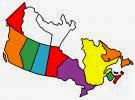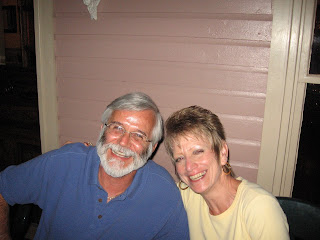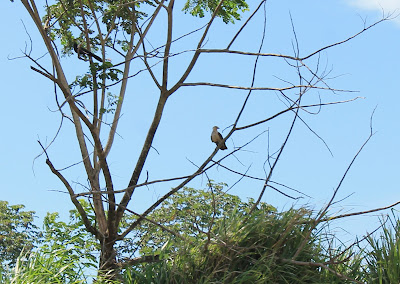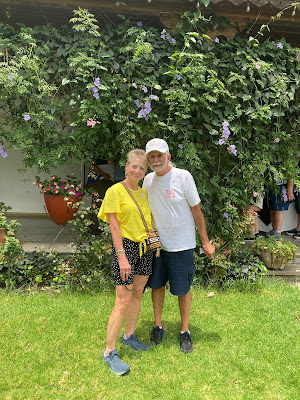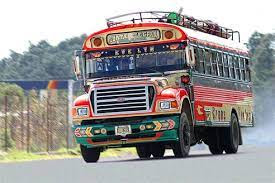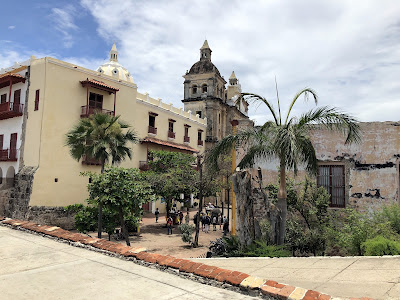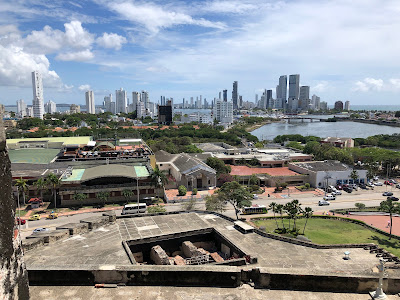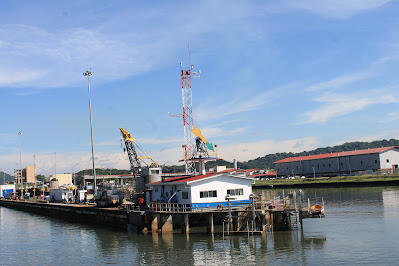We left Panama in the evening with a day at sea before our next port, Puerto Caldera, Costa Rica. We were now in the Pacific Ocean and were greeted by some big 21' waves. Most of the rough seas were at night and by noon the next day the waves were "only" 11'. Even with the big waves the Encore was very stable, unlike smaller ships we have been on during heavy weather.
Most of the ports where we stopped were primarily for commercial tankers, bulk carriers or container ships. This balk carrier in Puerto Caldera was being loaded when we arrived and had departed by the time we left in the afternoon.These short visits to countries do not give you a real feel for the country, but we could tell Costa Rica was more prosperous than many others we have visited. They have the second highest standard of living in Central America, in part because they do not have a military.
In Costa Rica we went on the aerial tram, river cruise and lunch excursion. We boarded a bus at the dock for the ride to the jungle. There we got on a tram like this one and went up the mountain through the jungle.
While we saw plenty of trees we were disappointed with how many animals we saw, not one monkey or snake.
We did see this lizard, but have no idea what kind it is.
The only bird we saw was this toucan.
This colorful insect accompanied us on our tram.
It is a rain forest, but it was not the rainy season so even the waterfalls were not that impressive.
After the tram ride our guide took us into the botanical garden where they grew many tropical food producing plants. This is a cashew tree. Who knew? Only one small nut at a time. Obviously, that is why they are so expensive.
A pineapple plant. We had a taste of pineapple and it was fantastic. It was so sweet it was like eating candy.
After that we entered the butterfly garden. They were so active it was difficult to get a good picture. This pic is of two blue morphos. When their wings are closed, like the top one, they aren't that impressive, but when they open up and fly they are beautiful. For lunch we had traditionally prepared chicken, beef, rice and beans that were all very good. I also got to try a local beer Portena Cerveza Artesanal IPA that was surprisingly good.
We were back on the bus heading to the river cruise part of the tour. If you want really fresh fish, it is available on the side of the road. We had seen several small fishing boats when we were coming into the port.
The cruise was aboard one of the Jungle Crocodile Safari boats.
In no time at all we saw crocodiles. We have seen many alligators but never crocodiles. These two were ready to preform for us.
Open wide. You can see why you would not want to encounter one in the water. With all the gators we have seen, seeing one with its mouth open is rare.
This one got really close to the boat, so the guide could get an up close picture. Most of the guests let him take a picture for them.
I thought the crocs we saw were just putting on a show, but this one on the other shore was also showing its teeth.
Even with all the crocs in the river, these cattle were relaxing right by the water.
We did see a lot of birds on the cruise, but most were far away. Here is an osprey looking for a meal.
A pair of Frigate birds. With only a couple exceptions most of the birds we saw we also see in Florida.
The cruise took us to the month of the river on the Pacific Ocean.
When we turned around to head back to the dock clouds were starting to cover the mountains. The tide was also going out and these boats that were tied up on shore were now grounded.
While the tram ride was disappointing overall the excursion was very worthwhile.
Day 9 was a relaxing day at sea.
The next morning we arrived in Puerto Quetzal, Guatemala. This port is the the largest on the Pacific Ocean in Guatemala. There were many ships anchored off shore and we were docked near the LPG terminal.
Our excursion here was to a coffee plantation. It is in the mountains where most people live to escape the humid weather along the coast. This is one of the countries 37 volcanoes. Four of these are active and eruptions are not unusual. The bus ride into the mountains was very neat.
The coffee plantation, Finca Columbia in addition to growing coffee has a club with a restaurant, and swimming pool.
The land was bought by our guides grandfather in 1925. The family first grew vegetables and later turned to growing coffee.
A banana tree. Unlike Columbia, where coffee is grown in the open, in Guatemala they plant the coffee where it is shaded by taller trees.
I did not know what to expect and was surprised how spindly the coffee plants were.
It is getting near the end of the growing season so they will soon be picking all the beans whether they are ripe or not.
Like all plants they age out and new plants must be planted.
Coffee beans on the trees.
The red ones are not yet ripe.
After they are picked, they spread the unripened ones out on the concrete until they dry.
These are not yet dry.
Before and after the beans are dried.
They sell most of the beans they grow to other coffee companies. They do roast some to use in their restaurant and sell in their store.
A bird of paradise.
After the tour we had a coffee party. The woman at the end of the table said it was the first time she had ever tasted coffee. Wow, we never go one day without our morning java.
Feeling better after our caffeine fix. It was interesting learning about how coffee is grown and processed, but the coffee was not bold enough for my taste.
Not sure what this says about the safety of the area. There were two guards with guns at the entrance of the plantation.
Public transportation in Guatemala, the chicken bus. They are locally known as camionetas and are the cheapest way to travel. The name comes from the fact that it is not uncommon for passengers to bring animals aboard after their shopping trips.
The flow from the 2018 eruption of 12,346' Fuego Volcano (Volcano of Fire). The eruption happen so fast that many people could not evacuate in time. It killed over 200 people and left 260 missing. It was the deadliest since 1929.
The eruption caused a five mile lava, lahars and pyroclastic, flow and put a dense plume of smoke and ash high into the air. Some concrete buildings survived but any wood was burned and in some cases buried.
At the dock there was a market with local artisans. Nanc bought a woven table runner.
We enjoyed our visits to Costa Rica and Guatemala, but, while the tours are very informative, they only give you a glimpse of what the countries are really like.
Our next two ports are in Mexico.
